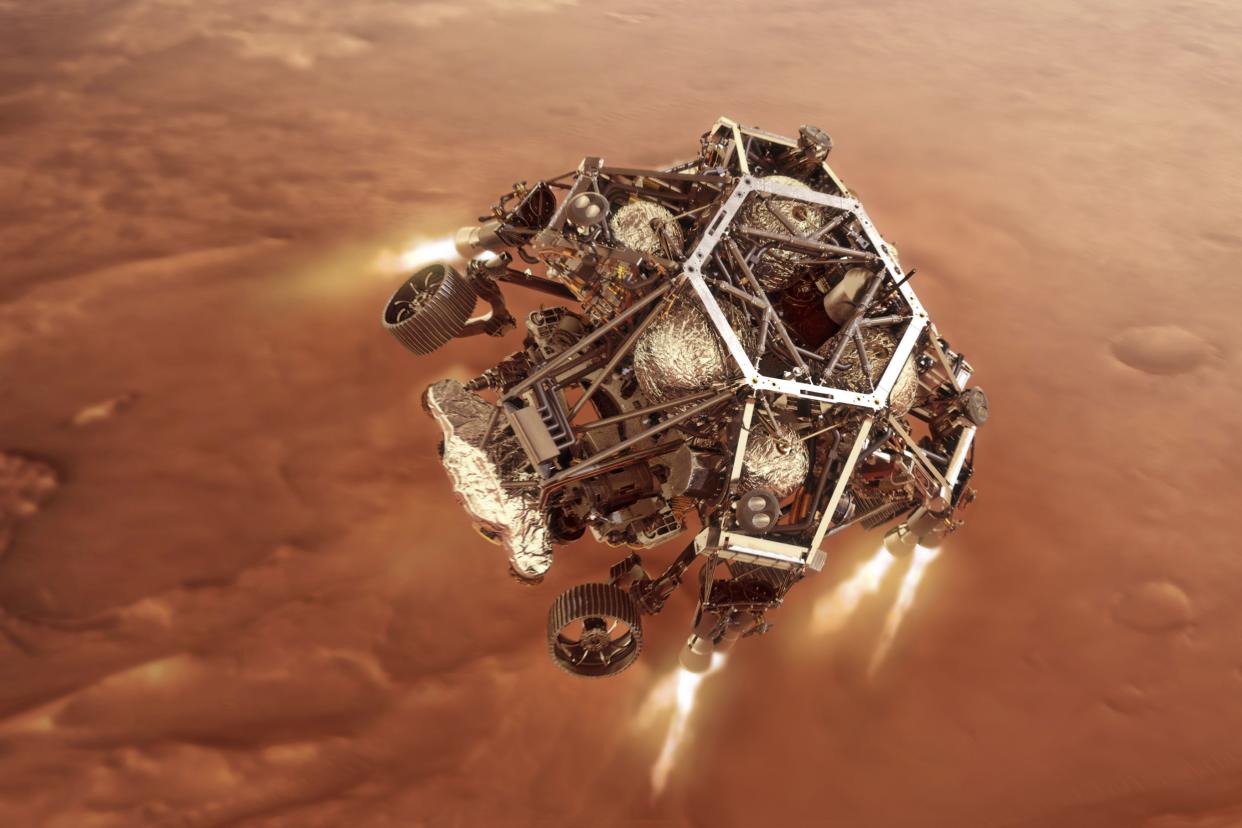SEE IT: Mars rover Perseverance lands on the red planet’s surface
The rover has landed.
NASA’s Perseverance rover made its way to the surface of Mars on Thursday, ending a journey of 292 million miles that began July 30 at Cape Canaveral in Florida.
The craft landed just before 4 p.m. and began its jam-packed mission of searching for signs of ancient civilizations, making the planet’s first audio recordings and launching a helicopter drone, named Ingenuity, that will fly around the planet.
Touchdown confirmed. The #CountdownToMars is complete, but the mission is just beginning. pic.twitter.com/UvOyXQhhN9
— NASA (@NASA) February 18, 2021
“Touchdown confirmed. The Countdown To Mars is complete, but the mission is just beginning,” the space agency captioned a short video of JPL personnel’s reaction to the landing at the control room in Pasadena, Calif., as the ebullient engineers slapped each other on the back and fist-bumped in celebration.
Among those watching was someone who knows a little about historic landings: Buzz Aldrin, who was on the Apollo 11 mission with Neil Armstrong and Michael Collins in 1969 and was the second man to walk on the moon, after Armstrong.
#Perseverance pays off! pic.twitter.com/nXsoKUqj3M
— Dr. Buzz Aldrin (@TheRealBuzz) February 18, 2021
Aldrin, 91, tweeted a photo of himself watching the jubilant reaction at Mission Control with the caption, “Perseverance pays off!”
Before the rover could explore a site where a lake existed 3.9 billion years ago, and eventually bring those samples back to Earth, the Perseverance had to land. Because of the limits of technology, NASA could send a sedan-sized rover to Mars, but it couldn’t watch that rover land.
The spacecraft had an 11-minute radio transmission and was completely out of contact with NASA during the “seven minutes of terror” as it descended to the surface from the top of the planet’s atmosphere, deployed a 70-foot supersonic parachute, jettisoned its heat shield and then used a rocket-steered platform called as a sky crane to guide the rover in the final 60 or so feet to the surface.

“Success is never assured,” Al Chen, head of the Jet Propulsion Lab, said earlier this week. “And that’s especially true when we’re trying to land the biggest, heaviest and most complicated rover we’ve ever built to the most dangerous site we’ve ever attempted to land at.”
However, the landing went off without a hitch and the rover began sending back images and data within minutes.
Hello, world. My first look at my forever home. #CountdownToMars pic.twitter.com/dkM9jE9I6X
— NASA's Perseverance Mars Rover (@NASAPersevere) February 18, 2021
The rover will settle in for the long haul as it probes below the surface looking for signs of ancient life. It will eventually collect dozens of chalk-size samples which will be sealed in tubes and set aside for a second rover that will take the material back to Earth, possibly as early as 2031.
Perseverance, the biggest, most advanced rover ever launched by NASA, is now the ninth spacecraft to successfully land on Mars since the 1970s. The previous crafts were all sent by NASA as well.
NASA offered several ways for people to tune in, including the agency’s public TV channel, website, app, YouTube channel, Twitter, Facebook, LinkedIn, Twitch, Daily Motion or THETA.TV.
The landing was the third instance of Mars activity from Earth this month after spacecraft from the United Arab Emirates and China reached the red planet’s orbit last week. All three missions launched around the same time in July when the Earth and Mars were more closely aligned during their respective trips around the sun.
With News Wire Services
